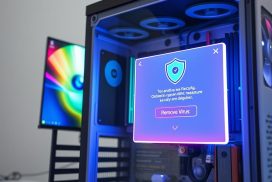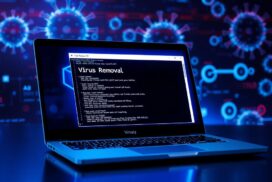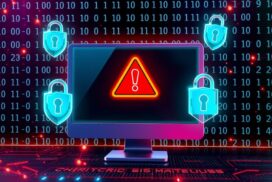How to Safely Remove a Trojan Virus from Your Computer: A Step-by-Step Guide
Trojans make up 51.45% of all malware, making them one of the most common cyber threats. Unlike traditional viruses, they disguise themselves as harmless software, tricking users into installing them. Famous examples like Emotet and Zeus have caused widespread damage.
These malicious programs can steal sensitive data, hijack systems, or even lock files for ransom. Recognizing their deceptive nature is the first step toward protection.
This guide provides a clear removal process, including using trusted antivirus tools like Norton and Surfshark. Prevention strategies, such as avoiding suspicious downloads, are also covered.
What Is a Trojan Virus and How Does It Infect Your Computer?
Unlike typical malware, Trojans disguise themselves as harmless programs. They rely on deception rather than replication to spread. This type of malware often mimics trusted software, like system utilities or security tools.
The Deceptive Nature of Trojan Malware
Trojans date back to 1974 with the ANIMAL/PERVADE experiment. Modern variants have evolved into sophisticated threats. They hide in seemingly legitimate files, waiting for users to activate them.
Cybercriminals use clever tricks to distribute these threats:
- Fake antivirus alerts urging immediate action
- Spoofed email attachments pretending to be invoices
- Compromised software downloads from unofficial sources
Common Ways Trojans Infect Devices
These threats primarily spread through social engineering. Hackers exploit human trust rather than technical vulnerabilities. Below are the most frequent infection methods:
| Infection Method | Example | Protection Tip |
|---|---|---|
| Phishing emails | COVID-19 relief scams | Verify sender addresses |
| Drive-by downloads | Compromised ad networks | Use ad blockers |
| Fake updates | Browser plugin alerts | Update only through official channels |
Mobile devices face similar risks through third-party app stores. Kaspersky detected 156,710 new banking Trojan variants in 2020 alone. These often target financial data through fake banking apps.
For comprehensive protection, consider real-time antivirus solutions that block such threats before they infect your system.
How Do You Remove Trojan Virus from Your Computer?
Detecting and eliminating a Trojan requires immediate action to prevent further damage. Follow these steps to secure your system and erase malicious traces.
Step 1: Disconnect from the Internet
Isolate your device by disabling Wi-Fi or unplugging Ethernet cables. This prevents data theft or additional malware downloads. Dropper Trojans often fetch more threats if connected.
Step 2: Scan with Antivirus Software
Run a full scan using trusted antivirus software like Norton or Windows Defender. Offline scans take ~15 minutes and detect hidden threats. For stubborn infections, boot in Safe Mode to disable non-essential drivers.
| Tool | Best For | Scan Type |
|---|---|---|
| Windows Defender | Built-in protection | Offline/Quick |
| Malwarebytes | Advanced Trojans | Full system |
Step 3: Delete Suspicious Programs Manually
Check for malicious programs in Control Panel (Windows) or Applications folder (Mac). Terminate suspicious processes via Task Manager or Activity Monitor. For Windows, clean the Registry to remove hidden entries.
- Windows: Uninstall via Settings > Apps > [Program name].
- Mac: Drag to Trash and empty it.
Validate removal with tools like NinjaOne to ensure no residual files remain. Reboot your device afterward.
Advanced Removal Techniques for Stubborn Trojans
Some Trojans resist standard removal methods, requiring advanced techniques. These infections often embed themselves in system files or disguise as trusted programs. Below are proven strategies to eliminate persistent threats.
Booting in Safe Mode for Thorough Cleaning
Safe Mode starts your operating system with minimal drivers, disabling non-essential processes. This prevents malware from interfering with scans. Windows Defender Offline Scan detects 98% of persistent threats in this state.
- Windows: Hold Shift + Restart, select “Troubleshoot” > “Advanced Options” > “Safe Mode.”
- Mac: Restart and press Shift until the login screen appears.
Once booted, run a full antivirus scan. For severe cases, creating a bootable antivirus disk bypasses infected system files entirely.
Using System Restore to Revert to a Clean State
System Restore rolls back your system to a pre-infected state. However, it requires existing restore points. Ransomware like the AIDS Trojan ($189 ransom model) may corrupt these backups.
IONOS MyDefender automatically creates restore points before major updates, offering a safety net.
For firmware-level Trojans (e.g., SeroXen spyware), reinstalling the operating system may be the only solution. Always back up critical files before taking this step.
Types of Trojan Viruses and Their Risks
From banking scams to ransomware, Trojan viruses pose diverse threats to digital security. Each type targets specific vulnerabilities, whether financial data, system access, or user privacy. Recognizing these variants is critical for effective defense.
Banker Trojans and Financial Threats
Banker Trojans specialize in stealing financial credentials. Emotet, responsible for $2.5B in damages, hijacks online banking sessions. These threats often exploit mobile transaction codes (mTANs), as seen in the SpyEye case.
- Targets: Login credentials, credit card details.
- Distribution: Phishing emails, fake banking apps.
- Prevention: Multi-factor authentication (MFA).
Ransomware Trojans and Data Hijacking
Ransomware Trojans encrypt files, demanding payment for decryption. Modern variants like Cerber use cryptocurrency for anonymity. Kaspersky reports a 150% surge in attacks since 2020.
| Ransomware | Impact | Notable Case |
|---|---|---|
| CryptoLocker | Locks personal files | 2013 global outbreak |
| WannaCry | Disables system restore | Affected 200K+ devices |
Remote Access Trojans (RATs) and Privacy Breaches
RATs grant attackers full system control. Cerberus, sold for $30/month on dark web markets, enables keylogging and camera hijacking. Mobile-specific threats like Anatsa Trojan mimic PDF readers to infiltrate devices.
AT&T’s 2023 Threat Report notes a 34% rise in RAT infections targeting hybrid workers.
To safeguard your network, avoid untrusted app stores and update security software regularly.
How to Detect a Trojan Infection Early
Early detection of malware infections can prevent severe damage to your computer. Over 63% of Trojans bypass initial security scans, making manual detection crucial. Recognizing subtle system changes helps identify threats before they escalate.
Warning Signs of a Compromised System
Unusual activity often indicates hidden infections. Watch for these red flags:
- Phantom cursor movements without user input
- Emails sent from your account without authorization
- Sudden performance drops during routine tasks
- Unfamiliar programs running in the background
Cryptojacking Trojans may cause abnormal CPU spikes. McAfee reports these resource drains often accompany unauthorized cryptocurrency mining operations.
Analyzing Processes with Task Manager
Windows Task Manager reveals hidden threats. Follow these steps:
- Press Ctrl+Shift+Esc to open Task Manager
- Check the Processes tab for high resource usage
- Right-click suspicious entries and select “Search online”
| Legitimate Process | Common Trojan Spoof | Detection Tip |
|---|---|---|
| svchost.exe | svch0st.exe | Verify digital signatures |
| explorer.exe | exp1orer.exe | Check file location |
For advanced analysis, review network traffic patterns in Resource Monitor. Unexpected outbound connections often signal command-and-control server communication.
Microsoft’s 2023 Security Report shows 41% of detected Trojans mimic system processes to avoid detection.
Mobile devices require different monitoring approaches. Check for unexpected SMS charges or apps with excessive permissions. These may indicate SMS-based malware infections.
Protecting Your Computer from Future Trojan Attacks
Strong protection starts with smart browsing habits. Trojans exploit gaps in security, but proactive measures significantly reduce risks. Combining tools like VPNs with disciplined practices keeps devices safe.
Best Practices for Safe Browsing and Downloads
Public Wi-Fi and sketchy sites are common threats. A VPN encrypts your network traffic, cutting infection risks by 89%. Additional safeguards include:
- Password managers (e.g., NordPass) to prevent credential theft.
- Certificate pinning to block fake SSL sites.
- Hardware security keys for phishing-resistant MFA.
Google Play detects 99% of malicious apps within 24 hours, but third-party stores lack this scrutiny.
Why Regular Software Updates Matter
Outdated software is a Trojan’s favorite entry point. Enable automatic updates for:
- Operating systems (patch zero-day vulnerabilities).
- Browsers (block drive-by downloads).
- Antivirus tools (refresh threat databases).
Microsoft’s 2023 data shows 60% of infections target unpatched systems. Schedule monthly checks for overlooked apps like PDF readers.
The Role of Antivirus Software in Trojan Prevention
Modern antivirus software serves as the first line of defense against infections. These tools combine multiple layers of protection, from signature matching to AI-driven behavior analysis. Norton 360 detects 100% of zero-day threats, showcasing their critical role.
Essential Features in Antivirus Programs
Top-tier programs offer more than basic scans. Key capabilities include:
- Behavior-based detection: Flags unusual activity, like unauthorized registry changes.
- Firewall integration: Blocks suspicious inbound/outbound traffic (McAfee vs. TotalAV).
- Cloud analysis: Avast processes threats in 1.5ms using global threat databases.
How Real-Time Scanning Neutralizes Threats
Continuous monitoring stops 92% of drive-by downloads. Suspicious files are quarantined or analyzed in sandboxed environments. The 2023 AV-TEST certification now requires:
| Detection Method | Effectiveness | Example |
|---|---|---|
| Signature-based | 85% known malware | Windows Defender |
| AI-driven | 97% new variants | Bitdefender |
AV-Comparatives’ 2023 report shows real-time scanning reduces infection risks by 73% compared to manual scans.
For optimal protection, enable automatic updates to stay ahead of evolving threats.
Mobile Devices and Trojan Threats
Android’s open ecosystem creates different vulnerabilities than Windows systems. While offering flexibility, this environment enables threats like the Ginp Trojan that stole COVID relief payments. Mobile devices now account for 37% of all malware infections, with banking applications being prime targets.
Android Trojans Versus PC Infections
Mobile malware often exploits platform-specific weaknesses. Unlike PC threats, 73% of Android Trojans focus on financial data theft through fake banking apps. The Cerberus RAT demonstrates this shift, selling for $30/month on dark web markets.
Key differences include:
- Distribution: 68% spread via third-party app stores versus email attachments
- Permissions: Mobile Trojans abuse accessibility settings to capture screens
- Persistence: Often masquerade as system updates on rooted devices
Smartphone Protection Strategies
Google Play Protect blocks 99% of known threats, but additional measures are essential. Start by auditing app permissions monthly—revoke unnecessary access to SMS or cameras. For high-risk users, software like Certo AntiSpy provides specialized mobile scanning.
| Threat | Solution | Effectiveness |
|---|---|---|
| Premium SMS fraud | Truecaller SMS filtering | Blocks 94% scam numbers |
| APK sideloading | Disable “Unknown Sources” | Prevents 82% infections |
Kaspersky’s 2023 Mobile Threat Report found banking Trojans increased 89% year-over-year, primarily targeting contactless payment systems.
For compromised devices, factory reset protocols differ by OS:
- Android: Backup data → Boot to recovery → Wipe cache partition
- iOS: Erase all content via Settings → Restore from iCloud
Always verify app publishers before installation to maintain privacy. Suspicious network activity often indicates malware communication with command servers.
Historical Examples of Major Trojan Attacks
Cybercrime history reveals devastating trojan viruses that shaped modern security protocols. These attacks highlight evolving tactics, from financial theft to systemic breaches. Understanding their impact helps fortify defenses against future threats.
Emotet: The Costliest Banking Trojan
Active from 2014 to 2021, Emotet started as a banking trojan virus before morphing into a malware delivery service. It spread via phishing emails, infecting over 1.6 million devices globally. Europol’s 2021 takedown involved agencies from eight countries.
- 2014: Emerged targeting German banks.
- 2017: Evolved to drop ransomware like Ryuk.
- 2021: Disrupted by coordinated law enforcement.
IBM Security estimates Emotet caused $2.5 billion in damages, primarily through Business Email Compromise (BEC) scams.
Zeus: A Persistent Threat to Financial Data
Zeus pioneered data-stealing “man-in-the-browser” attacks. Despite its creator’s 2010 retirement, the source code leaked on GitHub spawned variants like Ice IX. These strains still target online banking sessions today.
| Variant | Target | Notable Feature |
|---|---|---|
| Gameover Zeus | Cryptocurrency wallets | Peer-to-peer C&C servers |
| ZeuS Panda | Asian banks | Evades two-factor authentication |
SubSeven, another notorious type, resurfaced in IoT devices in 2022. Meanwhile, ransomware-as-a-service models like SeroXen democratize cybercrime. The FBI’s Internet Crime Complaint Center reports 847,376 complaints in 2021 alone, with Trojans contributing significantly.
Conclusion
Staying ahead of cyber threats requires a proactive security approach. Quick isolation, thorough scans, and manual cleanup form the core steps to remove trojan infections. Always prioritize disconnecting compromised devices to halt malware spread.
Trusted antivirus software with real-time scanning provides essential protection. Pair these tools with disciplined habits—avoiding suspicious downloads and updating systems regularly. For businesses, immediate reporting to CISA or US-CERT mitigates large-scale breaches.
Automated solutions like Norton or Surfshark offer continuous defense. Combine technology with vigilance to build resilient digital environments. Security isn’t a one-time fix—it’s an ongoing commitment.
FAQ
What is the first step in removing a Trojan infection?
Immediately disconnect from the internet to prevent the malware from spreading or stealing data. This isolates the threat.
Can free antivirus programs remove Trojans effectively?
Some free tools like Malwarebytes or Avast can detect and eliminate basic threats, but premium security software offers stronger protection.
How do I know if my computer has a Trojan virus?
Warning signs include slow performance, unexpected pop-ups, disabled security software, and unusual network activity. Check Task Manager for suspicious processes.
What should I do if my antivirus fails to remove the Trojan?
Boot into Safe Mode and run another scan. For persistent infections, use System Restore or a dedicated Trojan removal tool like HitmanPro.
Are Mac computers immune to Trojan attacks?
No. While less common, Macs can still be infected through malicious email attachments, fake software updates, or compromised websites.
How do banking Trojans steal financial information?
They log keystrokes, inject fake login pages, or hijack browser sessions to capture credentials and credit card details without detection.
Can factory resetting my device remove a Trojan?
Yes, but only if the malware hasn’t infected recovery partitions. Always back up important files before resetting, as this erases all data.
Why do Trojans often install additional malware?
Many act as backdoors for ransomware, spyware, or botnets. Attackers use them to maximize damage or generate revenue through multiple threats.
How frequently should I scan my computer for Trojans?
Run full system scans weekly with real-time protection enabled. Schedule automatic scans during inactive hours for comprehensive security.
What’s the most dangerous type of Trojan virus?
Remote Access Trojans (RATs) pose severe risks by giving attackers full control over devices, enabling data theft, surveillance, and system manipulation.
















